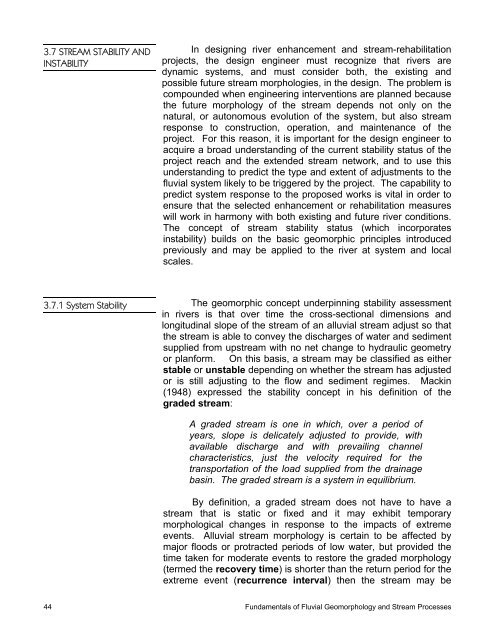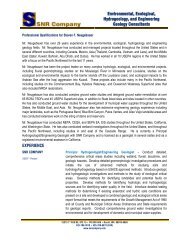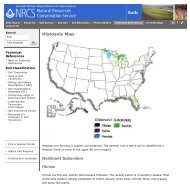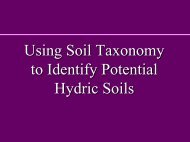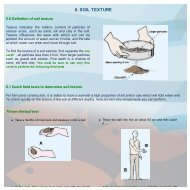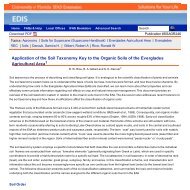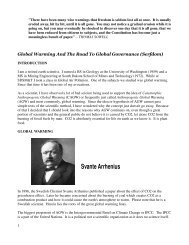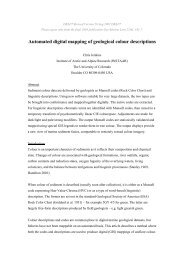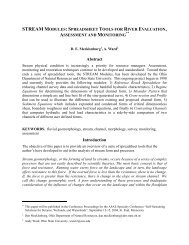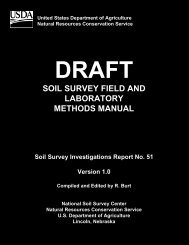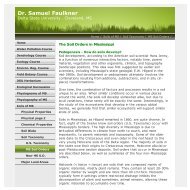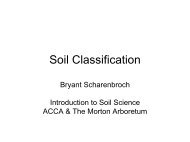chapter 3 fundamentals of fluvial geomorphology and stream ...
chapter 3 fundamentals of fluvial geomorphology and stream ...
chapter 3 fundamentals of fluvial geomorphology and stream ...
Create successful ePaper yourself
Turn your PDF publications into a flip-book with our unique Google optimized e-Paper software.
3.7 STREAM STABILITY ANDINSTABILITYIn designing river enhancement <strong>and</strong> <strong>stream</strong>-rehabilitationprojects, the design engineer must recognize that rivers aredynamic systems, <strong>and</strong> must consider both, the existing <strong>and</strong>possible future <strong>stream</strong> morphologies, in the design. The problem iscompounded when engineering interventions are planned becausethe future morphology <strong>of</strong> the <strong>stream</strong> depends not only on thenatural, or autonomous evolution <strong>of</strong> the system, but also <strong>stream</strong>response to construction, operation, <strong>and</strong> maintenance <strong>of</strong> theproject. For this reason, it is important for the design engineer toacquire a broad underst<strong>and</strong>ing <strong>of</strong> the current stability status <strong>of</strong> theproject reach <strong>and</strong> the extended <strong>stream</strong> network, <strong>and</strong> to use thisunderst<strong>and</strong>ing to predict the type <strong>and</strong> extent <strong>of</strong> adjustments to the<strong>fluvial</strong> system likely to be triggered by the project. The capability topredict system response to the proposed works is vital in order toensure that the selected enhancement or rehabilitation measureswill work in harmony with both existing <strong>and</strong> future river conditions.The concept <strong>of</strong> <strong>stream</strong> stability status (which incorporatesinstability) builds on the basic geomorphic principles introducedpreviously <strong>and</strong> may be applied to the river at system <strong>and</strong> localscales.3.7.1 System StabilityThe geomorphic concept underpinning stability assessmentin rivers is that over time the cross-sectional dimensions <strong>and</strong>longitudinal slope <strong>of</strong> the <strong>stream</strong> <strong>of</strong> an alluvial <strong>stream</strong> adjust so thatthe <strong>stream</strong> is able to convey the discharges <strong>of</strong> water <strong>and</strong> sedimentsupplied from up<strong>stream</strong> with no net change to hydraulic geometryor planform. On this basis, a <strong>stream</strong> may be classified as eitherstable or unstable depending on whether the <strong>stream</strong> has adjustedor is still adjusting to the flow <strong>and</strong> sediment regimes. Mackin(1948) expressed the stability concept in his definition <strong>of</strong> thegraded <strong>stream</strong>:A graded <strong>stream</strong> is one in which, over a period <strong>of</strong>years, slope is delicately adjusted to provide, withavailable discharge <strong>and</strong> with prevailing channelcharacteristics, just the velocity required for thetransportation <strong>of</strong> the load supplied from the drainagebasin. The graded <strong>stream</strong> is a system in equilibrium.By definition, a graded <strong>stream</strong> does not have to have a<strong>stream</strong> that is static or fixed <strong>and</strong> it may exhibit temporarymorphological changes in response to the impacts <strong>of</strong> extremeevents. Alluvial <strong>stream</strong> morphology is certain to be affected bymajor floods or protracted periods <strong>of</strong> low water, but provided thetime taken for moderate events to restore the graded morphology(termed the recovery time) is shorter than the return period for theextreme event (recurrence interval) then the <strong>stream</strong> may be44 Fundamentals <strong>of</strong> Fluvial Geomorphology <strong>and</strong> Stream Processes


